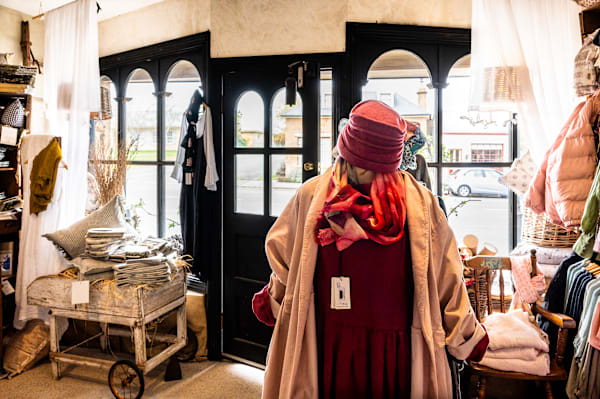photographer PEN TAYLER
A walk down the main street of Oatlands is a walk steeped in the recent history of our island. There are numerous intact Georgian buildings in the town, so many that the 2018 movie, The Nightingale, set in Tasmania’s colonial past, was filmed here. Today I’m looking for Elm Cottage which turns out to be about halfway down the main street. Rhonda Watt-Sykes, who describes herself as a rag trader and designer, opened the shop with her husband, Wally Sykes, in 2007.
“I have always been looking for a place that would inspire me,” she told me. “I have always been searching for the perfect location for the next photo shoot for my next collection. Definitely the architecture and history of Oatlands drew me here.” The couple were so drawn to Oatlands they moved from Queensland to be here, buying Elm Cottage in 2007. “We virtually moved into the store and opened approximately one month later, with patterns, stock, and an excitable amount of inspiration.”
As a child, Watt-Sykes was constantly drawing. When she was six, her father (who died that same year) gave her a set of Derwent Pencils and “all I remember doing is putting the different colours together”. But she wasn’t only interested in drawing – fashion was a big draw card for her as well. “In my teens, I was so interested in fashion I would virtually shop every day just to see what was in. Then I would bring something home and try and work out how it was put together.”

One day, she decided to try making a dress for herself. “My mother had remarried and I had a wonderful stepfather. He said, ‘Darling, if I gave you a bit of money – $200 – do you think you could make more and maybe sell them?’ I decided to do it. So with no formal training or any idea of what I was doing I made a pattern from newspaper and made 10 dresses.”
Inside Watt-Sykes’ small shop in Oatlands, it’s a hive of activity on the day I visit. A number of women look through her range of clothing (she has her own label), trying things on while quietly but animatedly discussing the colour and styles with each other, and occasionally their partners, who mostly stand off to one side with slightly glazed eyes or decide to go for a walk. The shop has a warm, friendly atmosphere with soft lighting coming in through the lovely arched windows which face onto the street. It feels as though history is all around me. At the rear of Watt-Sykes’ shop is the studio where she does her designing and creating. Racks of patterns hang in tight rows along the top of the room. There’s a large table for designing and cutting out, and a number of different types of sewing machines as befits a rag trader and designer.
In those early days when her stepfather offered her $200, he probably never imagined just how far young Rhonda’s talent would take her. “I went from there to designing approximately 15 to 20 different designs that I was cutting out, making and selling to the boutiques on the Gold Coast. Over the next 10 years I had seven agents selling all around Australia to different stockists. I supplied 150 stores each season including David Jones. At one point I employed 11 staff in house and had 35 out-working companies. The pressure was on as you need to do as many as three collections a year in very tight time constraints.”
Her creativity was recognised in the late 1990s when Watt-Sykes won a Retailers Association of Queensland fashion design award.

After working in such a high stress environment, “I love the relaxed life here in Tasmania. I can design and create with no pressure from department stores. Oatlands is a very welcoming community. We were blown away by how excited everybody was to have us open the store with my own label.”
Watt-Sykes usually wakes up thinking about the next piece or range she wants to make. “I can be anywhere and be inspired by my surroundings, hence living in Oatlands.” She has downsized significantly since those heady days in Queensland, but “I have a wonderful client base who keep coming back again and again, which would make it hard for me to move because we’ve become such a part of the town. We never expected to love Tasmania so much and make such wonderful friends who now feel like family. I look back at the photos of when we purchased Elm cottage and wonder what we were thinking!”
As for her creativity: “My motivation isn’t a problem, it’s finding time to do all the designs and creating that I still want to do.”
Pen Tayler is a Tasmanian writer and photographer. She photographed 12 towns for Towns of Tasmania, written by Bert Spinks, and has written and provided images for Hop Kilns of Tasmania (both Forty South Publishing). She has also written a book about Prospect House and Belmont House in the Coal River Valley.










